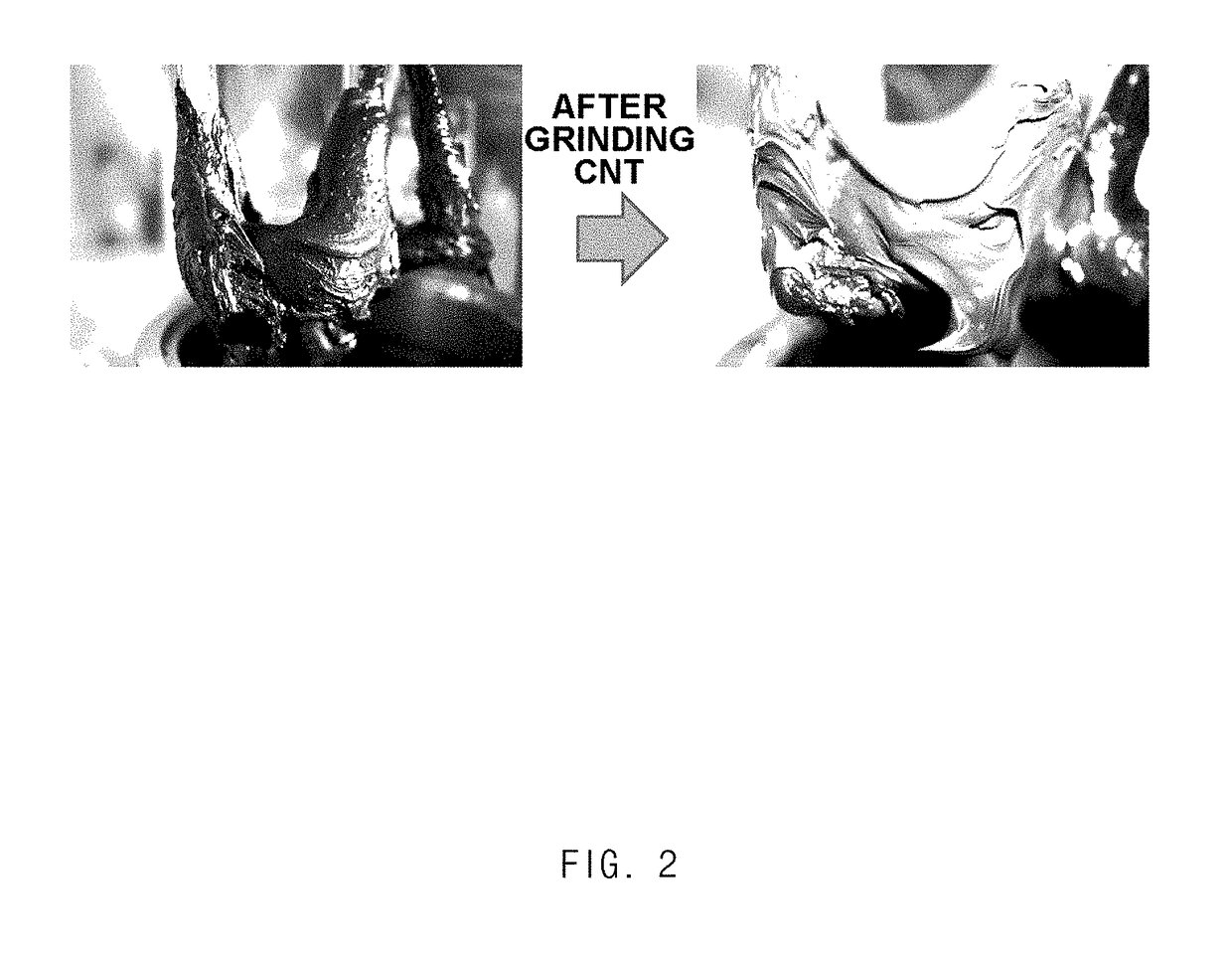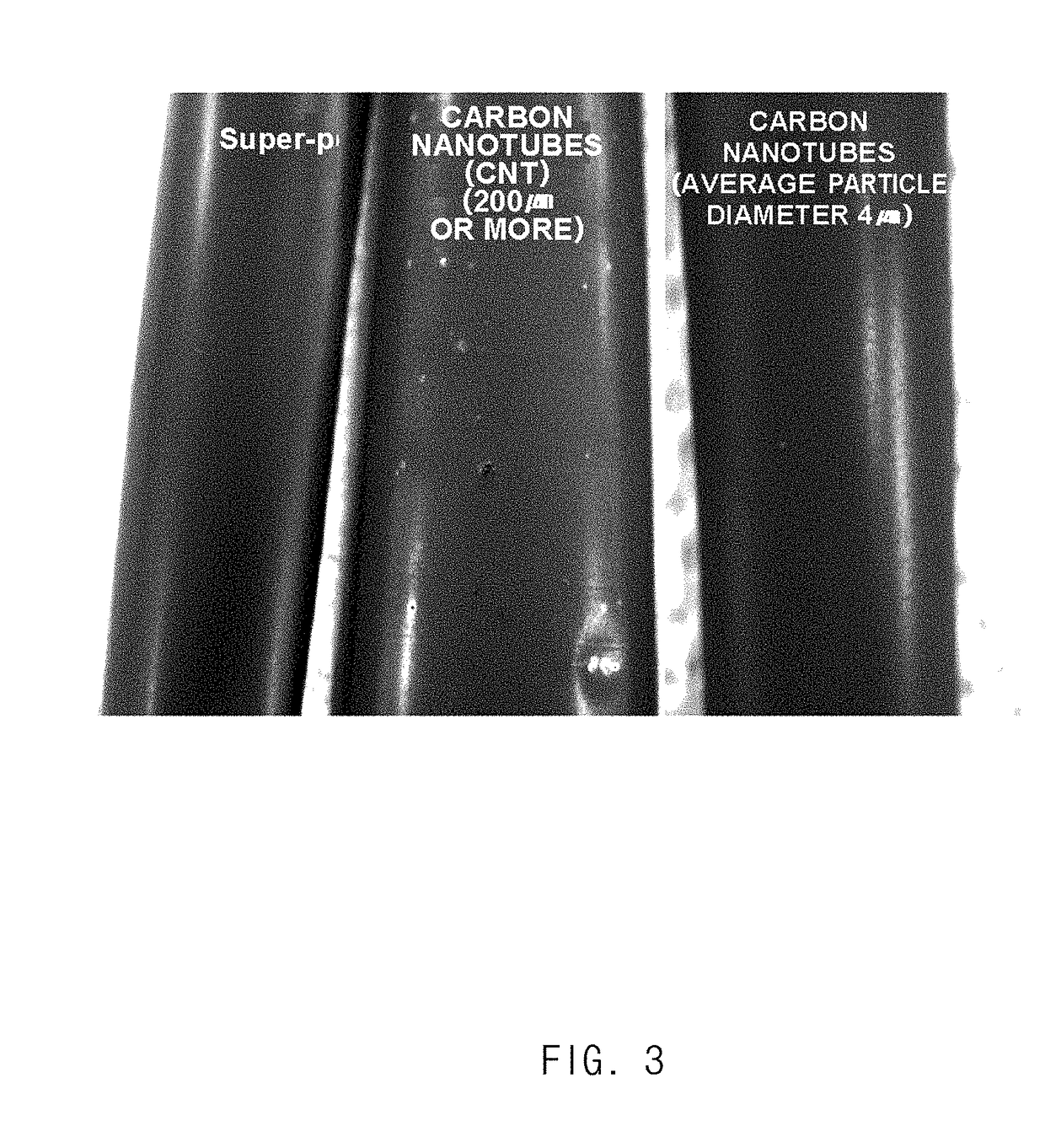Positive electrode material slurry for lithium secondary battery including at least two conductive materials and lithium secondary battery using the same
a lithium secondary battery and positive electrode technology, applied in the direction of batteries, cell components, electrochemical generators, etc., can solve the problems of limited amount of conductive agents and binder added, non-uniform cell performance, etc., and achieve the effect of improving the conductivity of an electrode and improving the characteristics of a secondary battery
- Summary
- Abstract
- Description
- Claims
- Application Information
AI Technical Summary
Benefits of technology
Problems solved by technology
Method used
Image
Examples
example 1
[0100]
[0101]A wet grinding process was performed on rope (entangled-type) carbon nanotubes having an average particle diameter of 200 μm using a high pressure homogenizer at a speed of 1,000 rpm for 3 hours. Subsequently, linear carbon nanotubes (CNTs) having an average length of 4 μm were prepared by drying the carbon nanotubes for one day.
[0102]
[0103]2 wt % of Super-P having an average particle diameter of 50 nm, as a first conductive agent, and 2 wt % of polyvinylidene fluoride (PVdF) as a binder were dissolved in an N-methyl-2-pyrrolidone (NMP) solvent, and 93 wt % of LiNi0.6Co0.2Mn0.2O2, as a positive electrode active material was then added and mixed to prepare a positive electrode active material slurry.
[0104]Subsequently, 2 wt % of the PVdF binder was further added while stirring the positive electrode active material slurry, and 1 wt % (conductive agent weight ratio 2:1) of the ground linear carbon nanotubes having an average length of 4 μm, as a second conductive agent, wh...
example 2
[0110]A lithium secondary battery was prepared in the same manner as in Example 1 except that a negative electrode mixture slurry was prepared by adding 95.5 wt % of carbon powder as a negative electrode active material, 2 wt % of carbon black as a conductive agent, wt % of CMC as a thickener, and 1.5 wt % of SBR, as a binder, to NMP as a solvent in the preparation of the lithium secondary battery.
experimental example
[0124]The secondary batteries prepared in Example 1 and Comparative Examples 1 to 6 were discharged under 0.2 C, 1 C, 2 C, and 5 C discharge conditions to mutually compare discharge capacities, and the results thereof are presented in the following Table 1 and FIGS. 9 to 11. In the following Table 1, the capacities under other discharge conditions were represented as relative values based on the 0.2 C discharge condition (100).
[0125]FIG. 9 illustrates discharge curves of the secondary batteries of Example 1 and Comparative Example 1 at 0.1 C, 2 C, and 5 C rates, respectively.
[0126]FIG. 10 illustrates discharge curves of the secondary batteries of Example 1 and Comparative Examples 2 and 3 at 0.1 C, 2 C, and 5 C rates, respectively.
[0127]FIG. 11 illustrates discharge curves of the secondary batteries of Example 1 and Comparative Examples 4 and 5 at 0.1 C, 2 C, and 5 C rates, respectively.
[0128]FIG. 12 illustrates discharge curves of the secondary batteries of Example 1 and Comparativ...
PUM
| Property | Measurement | Unit |
|---|---|---|
| length | aaaaa | aaaaa |
| particle diameter | aaaaa | aaaaa |
| particle diameter | aaaaa | aaaaa |
Abstract
Description
Claims
Application Information
 Login to View More
Login to View More - R&D
- Intellectual Property
- Life Sciences
- Materials
- Tech Scout
- Unparalleled Data Quality
- Higher Quality Content
- 60% Fewer Hallucinations
Browse by: Latest US Patents, China's latest patents, Technical Efficacy Thesaurus, Application Domain, Technology Topic, Popular Technical Reports.
© 2025 PatSnap. All rights reserved.Legal|Privacy policy|Modern Slavery Act Transparency Statement|Sitemap|About US| Contact US: help@patsnap.com



